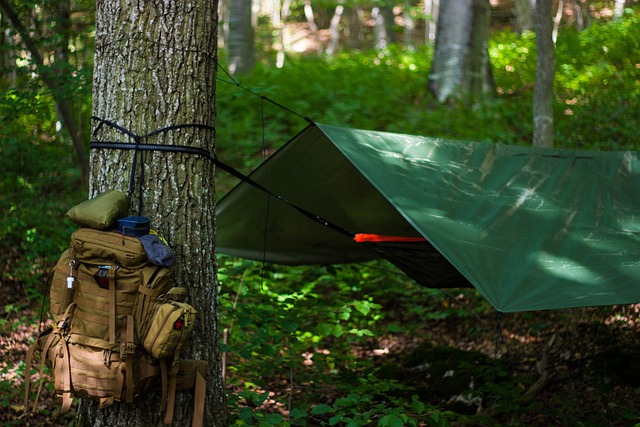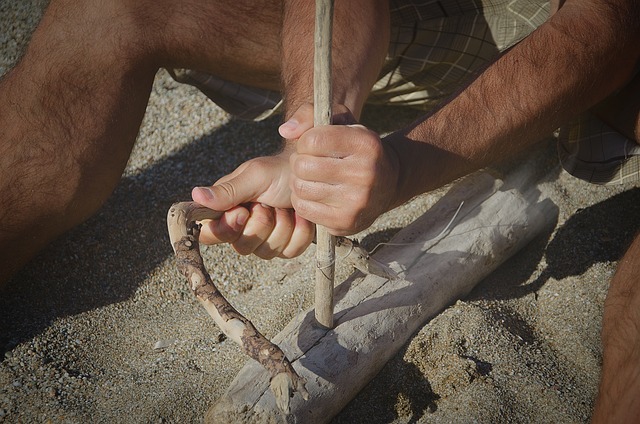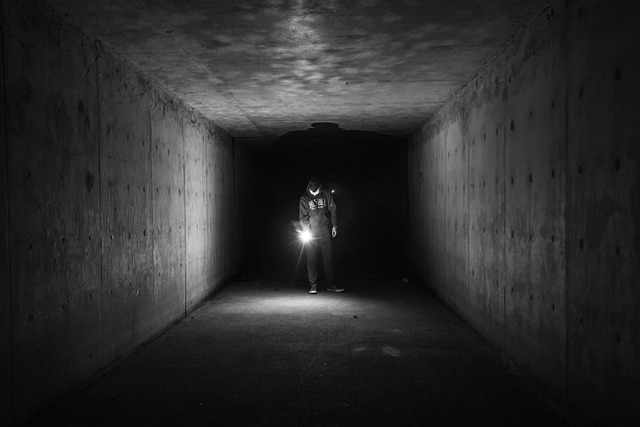When choosing a flashlight for hunting or survival situations, opt for one with advanced LED technology offering high lumen output for intense illumination, a durable construction typically made from anodized aluminum or titanium to withstand harsh environments, and a high waterproof rating (IPX7 or above) to function even when fully submerged. It should feature impact-resistant glass or polycarbonate lenses, various light modes for different tasks, and an anti-roll design. Ensure it's equipped with reliable power sources like rechargeable batteries or solar charging capabilities, and maintain it by storing it properly, keeping the lens clean, inspecting it regularly, and replacing batteries as needed to ensure it remains a dependable tool that can enhance your safety and effectiveness in any outdoor scenario.
When darkness falls or unforeseen events strike, a reliable compact flashlight becomes an indispensable tool for both hunting and survival. This article illuminates the critical role these miniature beacons play in various emergency scenarios, from navigating dense forests to signaling for help. We’ll explore key attributes of high-quality models, delve into the science of lumens and beam distance, and assess the impact of battery life on your safety and effectiveness in outdoor activities. Additionally, we’ll cover the types of flashlights best suited for survival use, the benefits of advanced LED technologies, and the importance of waterproof and impact-resistant designs. With practical tips for usage and guidance on maintenance to ensure longevity, this guide will equip you with the knowledge to choose the perfect compact flashlight for hunters and survivors alike. Flashlights For Hunting And Survival Situations are not just a luxury but a critical component of preparedness in challenging environments.
- Understanding the Role of Compact Flashlights in Hunting and Survival Scenarios
- Key Features to Look for in a High-Quality Compact Flashlight
- The Importance of Lumens, Beam Distance, and Battery Life in Emergency Situations
- Types of Compact Flashlights Suitable for Outdoor Activities and Survival Use
- Selecting the Right LED Technology for Optimal Visibility and Durability
- Waterproof and Impact-Resistant Flashlights: Your Reliable Companions in the Wild
- Practical Tips for Using Compact Flashlights During Hunting and Survival Situations
- How to Maintain and Care for Your Compact Flashlight for Long-Term Use
Understanding the Role of Compact Flashlights in Hunting and Survival Scenarios

Compact flashlights serve as indispensable tools for hunters and survivalists, offering both practical utility and psychological reassurance in low-light or nocturnal environments. In hunting scenarios, a reliable flashlight enhances visibility, allowing for precise aim and ethical harvesting of game. The focused beam of a high-quality compact flashlight can illuminate an area without giving away the hunter’s position, a critical aspect of stealth. It is particularly useful for tracking and identifying prey in varied terrains, from dense forests to open plains. Furthermore, these devices are durable and resistant to the elements, ensuring they function when needed most.
In survival situations, a compact flashlight goes beyond its role as a mere light source. It becomes a versatile tool that can signal for help, aid in navigation, and assist in various tasks requiring careful manipulation in the dark. The portability and ease of carrying these lights mean they are always at hand when unexpected events occur, from navigating through the wilderness to setting up camp after dusk. Their robust construction and long-lasting batteries make them a reliable companion for those who venture into environments where darkness can be as challenging as the terrain itself. Whether used for hunting or survival, compact flashlights are essential tools that ensure users maintain a competitive edge in the dark.
Key Features to Look for in a High-Quality Compact Flashlight

When selecting a high-quality compact flashlight for hunting and survival situations, it’s crucial to consider several key features that can enhance safety, visibility, and overall functionality in challenging environments. A durable construction with a robust design is essential; the flashlight should be able to withstand harsh conditions such as water exposure, dust, and impact without failing. Look for models made from high-strength materials like aircraft-grade aluminum or anodized stainless steel, which not only provide superior durability but also ensure the device remains lightweight and easy to handle.
In terms of illumination, a flashlight’s brightness level is paramount. Models that offer a high lumen output are ideal for penetrating darkness effectively, which is particularly important when hunting or navigating through unpredictable terrain in survival scenarios. Additionally, a reliable compact flashlight should have various light modes, including a high-beam setting for long-range visibility and low-beam options for prolonged use without draining the battery rapidly. Features like a focused beam for signaling or a wide flood for nearby tasks can be invaluable. Furthermore, consider a flashlight with a sturdy clip or a lanyard hole to attach it conveniently to your gear. It should also feature a user-friendly interface, allowing for quick and easy operation even when hands are cold or under stress. Lastly, battery life and charging options, such as USB rechargeability, are significant considerations to ensure the flashlight is ready when you need it most.
The Importance of Lumens, Beam Distance, and Battery Life in Emergency Situations

When a sudden emergency strikes, the reliability of your gear can mean the difference between safety and jeopardy. In hunting and survival situations, a flashlight is not just a tool but a critical companion that enhances visibility and provides reassurance in the dark. The importance of lumens, beam distance, and battery life cannot be overstated in these scenarios. Lumens measure the total amount of light a flashlight emits, and in an emergency, high lumen output can illuminate large areas or distant objects, critical for signaling or navigating unfamiliar terrain. For hunting specifically, a higher lumen flashlight can also improve the visibility of game, ensuring ethical and safe hunting practices.
Beam distance is another pivotal feature; it dictates how far the light can reach effectively. In an emergency, this translates to the ability to see potential hazards or locate help from afar. A long-distance beam can reveal obstacles in your path or guide you on a rescue mission. Battery life is equally crucial; a reliable flashlight should offer prolonged usage on a single charge, especially when stranded or caught in a situation where rescue may be hours away. The best flashlights for hunting and survival situations often come with high-capacity batteries or energy-efficient LED technology that can provide steady light output over an extended period. When selecting a flashlight for such purposes, prioritize models that offer high lumens, a far-reaching beam, and long battery life to ensure you’re well-prepared for any unforeseen events.
Types of Compact Flashlights Suitable for Outdoor Activities and Survival Use

When venturing into the wilderness or preparing for unexpected emergencies, a reliable flashlight is an indispensable tool for any hunter or survivalist. Compact flashlights designed for hunting and survival situations are tailored to withstand the rigors of outdoor activities while providing sufficient illumination in low-light conditions. These flashlights often feature rugged construction, with durable materials like anodized aluminum or aircraft-grade metal to ensure they can endure drops, water exposure, and the rough handling that comes with being outdoors.
Furthermore, these compact flashlights are engineered with high-intensity LEDs that offer both a powerful beam for long-distance signaling and a lower lumen setting ideal for close-range tasks like map reading or repairing gear. The beam intensity can be critical when trying to attract attention in the event of an emergency or when scanning the environment for potential threats or wildlife. Additionally, many models come with various modes and settings, including strobe and SOS signals, which are useful for survival scenarios. Features such as adjustable focus, rechargeable batteries, and a compact size that fits comfortably in a pocket or pack make them versatile and user-friendly for extended excursions or critical situations where every gram counts and visibility is paramount.
Selecting the Right LED Technology for Optimal Visibility and Durability

When selecting a compact flashlight for hunting and survival situations, the choice of LED technology plays a pivotal role in ensuring optimal visibility and durability in critical moments. The most effective LED options for such scenarios are typically those with high lumen output, offering intense beams that can illuminate distant objects or signals for rescue. A flashlight’s LED should possess a clear lens, free from distortions, to transmit light efficiently and without scattering, which is crucial when the situation demands precise visibility. Additionally, the LED’s color temperature significantly influences the color rendering index (CRI), thereby affecting how well colors can be distinguished in low-light environments. A neutral white LED with a high CRI is preferred for its natural representation of colors, which can be particularly beneficial for tasks such as tracking or identifying wildlife, or assessing one’s surroundings when caught in an emergency.
Durability is another key factor, as hunting and survival situations often involve rough terrain and unpredictable weather conditions. The LED flashlight must be encased in a robust housing that can withstand impacts, water, dust, and other environmental challenges without failure. A high-quality anodized aluminum body or a more rugged material like titanium is recommended for its lightweight properties and superior strength. Furthermore, the flashlight should feature impact-resistant glass or a polycarbonate lens to ensure that the LED remains intact even if the flashlight is dropped or struck. Features such as a anti-roll design, a waterproof rating (IPX7 or higher), and a sturdy pocket clip are also valuable for maintaining a secure grip and prolonging the flashlight’s lifespan in the field.
Waterproof and Impact-Resistant Flashlights: Your Reliable Companions in the Wild

In unpredictable environments, a reliable light source is an indispensable tool for any hunter or survivalist. Flashlights designed for hunting and survival situations are engineered to withstand the harshest conditions. These compact flashlights boast exceptional waterproof capabilities, ensuring they remain operational even when submerged in water. This feature is particularly crucial when navigating through wet terrains or during sudden rainstorms in the wild. Furthermore, impact-resistant flashlights are built to endure the rigors of outdoor activities. They can survive drops from considerable heights without shattering, thanks to their robust construction and impact-resistant materials. This resilience is not just for the sake of the light itself but also to protect its contents—durable LED bulbs that provide bright, focused beams over long distances, illuminating your path or highlighting game in low-light conditions. These flashlights are a testament to the ingenuity of modern design, offering users peace of mind that their light source will not fail them when they need it most. Whether you’re setting up camp after dark or signaling for help, a high-quality, waterproof, and impact-resistant flashlight is your reliable companion in the wild, ready to accompany you on every hunting and survival adventure.
Practical Tips for Using Compact Flashlights During Hunting and Survival Situations

When venturing into the wilderness for a hunting trip or finding yourself in a survival situation, the reliability of a compact flashlight becomes paramount. These devices are not just tools for illumination but can be critical for navigation and safety. To maximize their utility during such activities, consider these practical tips:
Firstly, opt for high-quality flashlights designed specifically for hunting and survival scenarios. These models often feature robust construction, reliable power sources like rechargeable batteries or solar charging capabilities, and durability to withstand harsh environments. They should also offer various light modes, including a strong beam for long-distance signaling and a dimmer setting for preserving night vision when stalking game.
Secondly, always keep your flashlight easily accessible. Whether attached to your person or stored in an readily grabbable location within your pack, the speed at which you can deploy your light can be crucial. In hunting situations, sudden movements or nocturnal activities may require immediate illumination. Similarly, in survival circumstances, finding shelter or navigating unfamiliar terrain after dark will necessitate a swift response. Additionally, familiarize yourself with the flashlight’s operation beforehand to avoid fumbling with settings during critical moments.
In terms of maintenance, ensure your compact flashlight is always clean and functioning. Regularly inspect the lens for scratches that could impair its effectiveness, check the battery level, and replace it as necessary. Carrying extra batteries or a charging option can prevent you from being left in darkness when you need it most.
Lastly, practice using your flashlight under various conditions to understand its limitations and capabilities. This will help you make informed decisions about which light settings to use based on the task at hand, whether it’s for signaling, reading a map, or navigating through dense foliage. With proper preparation and understanding of your flashlight’s features, you can enhance your safety and effectiveness in both hunting and survival situations.
How to Maintain and Care for Your Compact Flashlight for Long-Term Use

Maintaining and caring for your compact flashlight is crucial for ensuring its reliability, especially in hunting and survival situations where lighting can be a matter of safety and success. To prolong the lifespan of your flashlight, begin by handling it with care to prevent physical damage. Regularly inspect the body and lens for cracks or abrasions that could compromise its performance under pressure. When not in use, store the flashlight in a cool, dry place to protect the battery and electrical components from extreme temperatures and humidity, which can shorten its lifespan.
For optimal performance, use the appropriate type of batteries recommended by the manufacturer and replace them before they become fully depleted. This helps prevent strain on the flashlight’s circuitry. Additionally, clean the lens and reflector regularly to remove any accumulated grime or residue that could scatter or block the light. A soft, lint-free cloth should be used for cleaning; never use abrasive materials that might scratch the surface. To maintain consistency in brightness across the beam, periodically check the focus and adjust if necessary. Regularly testing the flashlight in various conditions will also help you gauge its performance and ensure it’s always ready when needed in hunting and survival scenarios. Proper maintenance not only extends the life of your compact flashlight but also enhances its effectiveness as a tool for navigating and surviving in low-light environments.
When venturing into the wilderness or preparing for unforeseen emergencies, a compact flashlight emerges as an indispensable tool for hunters and survivalists alike. As outlined in this article, the selection of a high-quality flashlight with robust LED technology, optimal lumen output, and substantial battery life is paramount for ensuring visibility and safety during hunting trips or when navigating through challenging environments. Waterproof and impact-resistant models offer additional reliability, making them ideal for outdoor activities and survival use. By following the practical tips provided and adhering to maintenance best practices, your flashlight can serve as a steadfast companion, illuminating your path and aiding in critical tasks when traditional sources of light are unavailable. In conclusion, a well-chosen compact flashlight is not merely a hunting or survival accessory; it’s a vital piece of gear that can significantly enhance your preparedness for any situation you may encounter in the great outdoors.


